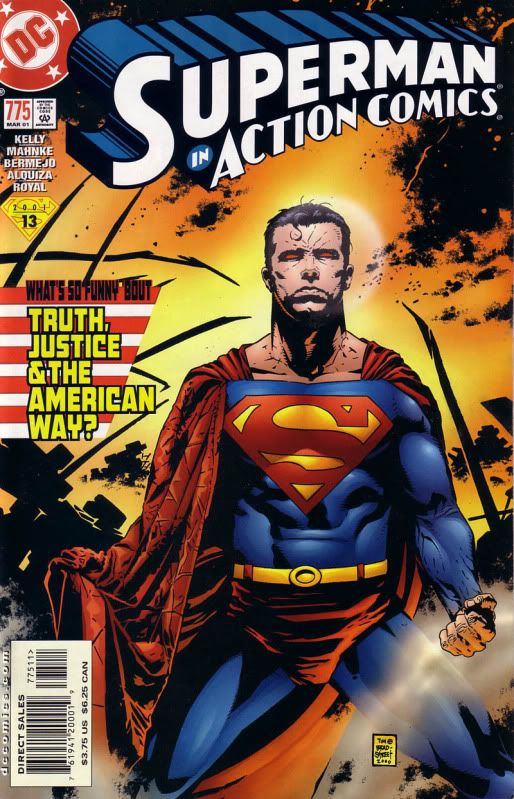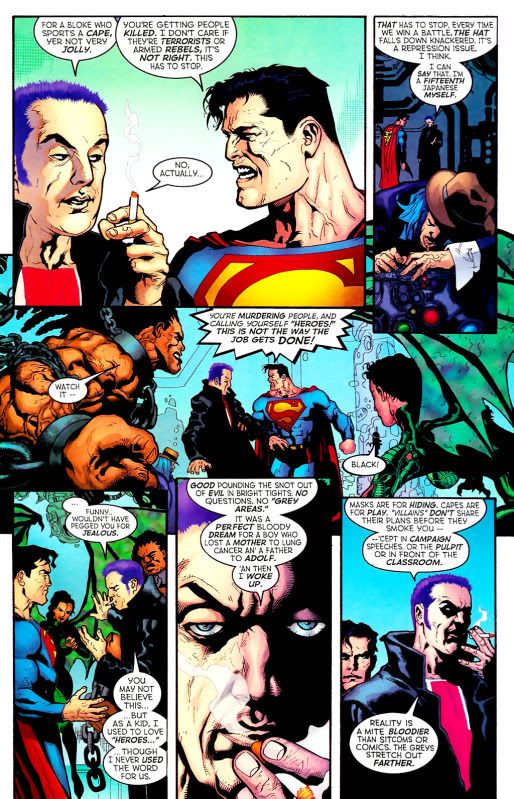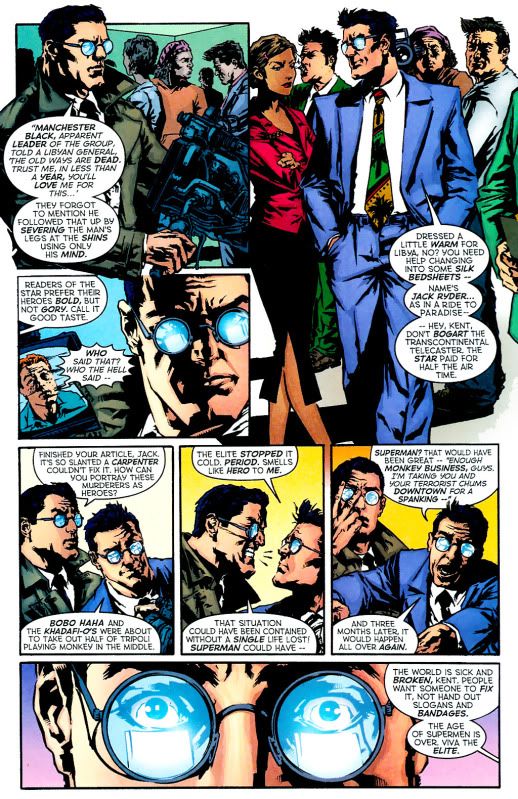
Joe Kelly, writer. Doug Mahnke and Lee Bermejo, pencillers.
DC Comics, 2001.
“Masks are for hiding. Capes are for play. ‘Villains’ don’t share their plans before they smoke you — ‘cept in campaign speeches. Or the pulpit or in front of the classroom. Reality is a mite bloodier than sitcoms or comics. The greys stretch out farther… Evil scientists. Bogey-men. Gimps in tights who want to ‘rule the world.’ From now on they’re yours — and the rest are ours to do with as we see fit.”
— Manchester Black (leader of The Elite) speaking to Superman
Despite some things you might have heard me say, or what you might have read in my diary that I keep under my pillow, I don’t really care about Superman in the greater context of things. I don’t spend a lot of time thinking about the Clark / Superman dichotomy, or what principles Superman embodies. If anything, I agree with Gary Groth’s 1988 essay that really Superman is a symbol of commercialism, exploitation, and the gangster morality of the comics industry. I love the first Christopher Reeve movie. And I like the character to the extent that he opens the door to stories in which, say, Jimmy Olsen uses a “Helmet of Hate” to turn Superman into a red devil with horns and then the horns crack open and tiny Supermen fly out, all drawn in an almost inappropriately naturalistic way by Curt Swan.
But the one thing that does get up my goat (is that an expression?) is when people say: “I don’t like Superman. He’s just a boy scout. He’s all powerful. He’s too simple. That’s not interesting as a character.” This is strictly incorrect. The reason Superman is uninteresting as a character is that his origin is so poorly conceived that if you spend any time thinking about it, you can’t get passed the preposterousness of it to consider anything else.
No. Superman is a one-dimensional character. Of that there is no dispute, but in my mind that is precisely the thing that makes him interesting. I have sometimes heard Mark Waid speak with eloquence about him and been almost convinced there’s something more there, but as Alan Moore once said:
The DC comics were always a lot more true blue. Very enjoyable, but they were big, brave uncles and aunties who probably insisted on a high standard of you know mental and physical hygiene. Whereas the Stan Lee stuff, the Marvel comics, he went from one dimensional characters whose only characteristic was they dressed up in costumes and did good. Whereas Stan Lee had this huge break through of two-dimensional characters. So, they dress up in costumes and do good, but they’ve got a bad heart.
This from the man who wrote two of the best Superman stories of all time.
But as I’ve said elsewhere, this is precisely the reason I can enjoy Superman or Batman. They are empty vessels that you can fill with any flavour or viscosity concoction that you like. If you are lucky, someone may one day come along to stand on the broken backs of Siegel and Schuster to fill that vessel up with a beverage that is to your liking. That’s less likely with the Marvel characters since they are almost always crippled by some “character trait” which, like a dollop of turd on a toothpick, must always be placed in the cocktail.
Now let me mix some moonshine for you.
Being good — I mean all good, all the time — is not simple or uninteresting. Go try it. It’s fucking hard. Don’t download anything. When you see a car broken down, stop to help out. Do unto others. Assume Hitler and Idi Amin could have been rehabilitated. You don’t really want to do all these things, but you do them because it’s the right thing to do. Because you think they’ll make the world a better place for all of us to live in.
The real world is a shit hole. There is the source of conflict in your Superman narrative right there. Trying to make it better is a source of conflict and is therefore a (possible) point of interest depending on how it’s presented. I find it interesting anyway. Just like dragons don’t exist, so it might be interesting to imagine if they were real. What if there was a paragon of virtue in this world who tried to lead by example?
Well, if you’re not going to do a Superman story about his horns cracking open and little Supermen flying out, then this is really the only option. I don’t like “gray area” Superman stories where, say, he’s forced to go up against a corrupt government (or one that misunderstands him) and, therefore, his ideals are called into question. And, look, I’m a guy who’s read something like 600 issues of Punisher comics. I don’t have issues with gray areas — I just have issues with gray areas in a Superman comic.
Sometimes, they bring his megapowers into it and we have stories about Superman trying to, literally, physically fix the world’s problems. In those stories, you have to go a little gray, about as far as I can handle. I’m thinking of, say, “Must There Be a Superman?” or even “The Amazing Story of Superman-Red and Superman-Blue”.
Action 775, cover dated March 2001, is a 40-pager that gets it mostly right.
A snooty new British superhero team called The Elite with a Cockney leader appears out of nowhere. They arrive at scenes of crisis before Superman and use lethal force as standard operating procedure. With their powers combined, they appear to be far more powerful than Superman. Superman is of course infuriated by their actions and morally opposed to them, but is seemingly not powerful enough to do anything about it. And, they believe in the rightness of their actions.

Superman is finally challenged to an ultimate confrontation, and about page 25 the obligatory superhero fist fight begins in which Superman manages to use his wits to work around the collective powers of The Elite while standing by his principles and not killing them (though he appears to).
As superhero comics go, this is a pretty great one. It is a well-executed, exciting premise. The art by Doug Mahnke is tight, gritty, and always interesting (assisted by six inkers!) — he’s come a long way since The Mask! There are a few of his pages that I struggled to understand though, even after staring at them for a while. Lee Bermejo draws a few pages as well, and while I usually love the way he draws Superman there’s baffling page here in which he draws Clark and another reporter and they look identical and the other guy is wearing a blue suit — like, what?!? Tim Bradstreet is an odd choice for a Superman cover, but I’m not complaining. I liked the character moments, like the scene with Lois and Clark in bed together before the major battle.


Unfortunately, like most Superman comics, the whole thing starts to unravel the more you think about it. Superman draws the line at killing, but he beats the shit out of these guys, so what’s the message about violence here? Also — and this is the book’s fatal flaw — Superman is only able to stand by his ideals because of his powers. He’s able to use heat vision etc to cut out a chunk of Black’s brain and incapacitate him. What if he didn’t have those powers? Would he have simply fought to his own death?
And I think the book may be somewhat dated. I wonder what it would have looked like post-9/11. After all, the story is titled: “What’s so funny about Truth, Justice, & The American Way?” — a darkly ironic title the more you think about it in a real world context. And the issue is obviously a commentary on the wildly popular anti-hero comics of the time — particularly The Authority — by UK writers like Garth Ennis, Mark Millar, Grant Morrison, and Warren Ellis.
Well, I say “obviously” but, in fact, while this comic appeared to take a position against those kinds of comics, it spun off a few short years later into an Elite miniseries, so really, sadly, predictably, on the other side of this rare inspiring story, it stinks of DC trying to get their hands in the pie. So, as ever, once again, Superman becomes a symbol of commercialism, exploitation, and the gangster morality of the comics industry. Now that’s what I call standing by your ideals.
KS
P.S. Please ignore everything in this essay, and go read some Tom Crippen.
————————————————————————————-
Kumar Sivasubramanian is the writer of Weird Crime Theater.
